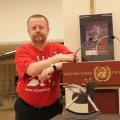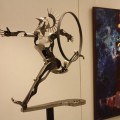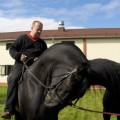Ivanov, a New Hellene
The great German philosopher Martin Heidegger read Ancient Greeks daily: an hour or two every day for fifty years. He was convinced that the European culture originates entirely in Antiquity.
 Volodymyr Ivanov, a famous Ukrainian sculptor, shares that conviction. As a young man he took part in archeological digs of Olvia and Khersones (ancient cities of Northern coast of the Black Sea), and at once fell in love with that ancient culture and spirit. He has been immersed in the ancient Hellenic world ever since. Achilles, Amazons, Minotaur, all ancient gods and heroes – he dreams about them. He believes the antique plastic art to be the only universal language understood by everyone. The ancient world's joyfulness, sense of a healthy trained body, calm friendliness of a warrior is the basis of the European perception of the world. The UN peaceful principles were achieved through the suffering of World War II. Vladimir Ivanov’s sunny Quadriga radiates peacefulness and optimism.
Volodymyr Ivanov, a famous Ukrainian sculptor, shares that conviction. As a young man he took part in archeological digs of Olvia and Khersones (ancient cities of Northern coast of the Black Sea), and at once fell in love with that ancient culture and spirit. He has been immersed in the ancient Hellenic world ever since. Achilles, Amazons, Minotaur, all ancient gods and heroes – he dreams about them. He believes the antique plastic art to be the only universal language understood by everyone. The ancient world's joyfulness, sense of a healthy trained body, calm friendliness of a warrior is the basis of the European perception of the world. The UN peaceful principles were achieved through the suffering of World War II. Vladimir Ivanov’s sunny Quadriga radiates peacefulness and optimism.
Neatly arranged ranks of gods and heroes have come to Geneva from a mysterious island in the Black Sea. Ancient Greeks named it “Levka” (“The Shining Island”). According to a legend Achilles is spending the eternity at that very place: the legend tells how Achilles's mother Thetis beseeched Poseidon to raise rocks above the sea and create “an island of bliss” for hero's eternal residence. Vladimir Ivanov believes that the island is an unsinkable temple to Achilles. The first part of Vladimir Ivanov’s project “Gift of Poseidon” was an exhibition held on the island in in July 2008. And now this exhibition has come to Geneva. Geneva is a great city for dreamers. Here Jean Jacques Rousseau, a famous child of the Enlightenment, dreamed about us all becoming like children, like Ancient Greeks. Here Wagner dreamed about the great European spirit's revival. Is there a place on Earth better than Lake Geneva's shore to try on a tunic once more or dream about simplicity and naturalness, joy and strength?
The time is gone when Donatello could leave work behind and run 40 kilometers to look at a newly excavated antique statue, in order to carve a marble replica himself. Now from anywhere in the world, say Guinea, one only has to type http://www.elgephest.com into an old computer – and get transported straight into an antique web-fairy tale designed according to the latest technology: to Vladimir Ivanov’s web site (named best personal page in Ukraine in 2008).
Vladimir Ivanov is one of the most technology-savvy sculptors in Ukraine. He works with modern welding and metal-cutting equipment. The massive black steel, sparkling stainless steel, fiery welding arcs – his workshop looks like that of the legendary Hephaestus. So the name of the international sculptors group founded by Ivanov in the end of the 80's, “Electrohephaestus” was not chosen accidentally. The group was first formed in his native Kiev, in the Paton Institute of Electric Welding famous for its innovative approache, and then moved to Saarbrucken, Germany.
 Steel and welding or being in Germany have not transformed the Greek Ivanov into a “conceptualist Bois”. Ivanov is as though bewitched by the antique plastic art perception. Though he does not smooth down marble but welds with an argon arc, his plasticity, contrappostos, mass ratios are positively Greek. Plasticity of a runner bearing a victory message. This victorious plasticity is literally built into space like in Greek vase paintings. A ringing stroke of a silhouette – Apollo’s arrow flight. Springy silhouette, dynamic black-and-white contrasts; there is no place for uncertainty and amorphousness. Cezanne once dreamed to paint not the surface of the mountain St. Victoria but its skeleton, the tectonics that had created it. Ivanov starts by welding such a skeleton.
Steel and welding or being in Germany have not transformed the Greek Ivanov into a “conceptualist Bois”. Ivanov is as though bewitched by the antique plastic art perception. Though he does not smooth down marble but welds with an argon arc, his plasticity, contrappostos, mass ratios are positively Greek. Plasticity of a runner bearing a victory message. This victorious plasticity is literally built into space like in Greek vase paintings. A ringing stroke of a silhouette – Apollo’s arrow flight. Springy silhouette, dynamic black-and-white contrasts; there is no place for uncertainty and amorphousness. Cezanne once dreamed to paint not the surface of the mountain St. Victoria but its skeleton, the tectonics that had created it. Ivanov starts by welding such a skeleton.
In the 20's, after a horrible war Pablo Picasso turned his attention back to Antiquity. Expectations of a simple and clear world perception permeated the air. His friend Julio Gonzalez was the first to begin welding skeletons of this world perception from metal. An eternal antique (European) story: when we are unhappy we drop back to the beginnings; to Gaea-Earth. After all the “-isms” of the 20th century, exhausted with postmodernism,we once again long for a simple and clear idea. Is not “the Greek” Ivanov that very fairy-tale dwarf who has saved for us its fresh breath in his Kiev – Saarbrucken smithy?
Le Corbusier once dreamed about harmonious green cities full of light and Cartesian rationale, with sun-filled city squares. Ivanov’s weightless quadriga or his proud Amazon might just soar above that square. Ivanov’s sculptures are meant for that Ideal City of philosophers Campanella dreamed about.
 Nietzsche once noted that the main problem of modern mankind is the loss of aristocratism and of the vertical dimension. It is difficult to find a more aristocratic sculptor than Vladimir Ivanov. He is worried far more about the harmony of a horseman's pose than about problems of any Arte Povera. His exhibitions are held not only at museums, galleries, art shows and banks, but at famous equestrian clubs, for example, at the legendary Hanover auction for the best 3-year old horses in Verden, Germany. Ivanov is a horse fan, he has been a rider from the age of four. Therefore if he makes an Irish racehorse he creates exactly an Irish racehorse. He worships Marino Marini and says that his horseman and horse are not just a figure but represent the relationship between a man and the world. A genuine horsemen is sensitive to his horse. Horseman Ivanov in the end of 80's helped found the Ukrainian Green Party, he calls to be sensitive to our Earth. Sculpture led him away from politics activity, and Sculpture has led him to the Geneva Palace of Nations, which (we hope!) thinks and reigns wisely and humanely like a good horseman reigns his horse.
Nietzsche once noted that the main problem of modern mankind is the loss of aristocratism and of the vertical dimension. It is difficult to find a more aristocratic sculptor than Vladimir Ivanov. He is worried far more about the harmony of a horseman's pose than about problems of any Arte Povera. His exhibitions are held not only at museums, galleries, art shows and banks, but at famous equestrian clubs, for example, at the legendary Hanover auction for the best 3-year old horses in Verden, Germany. Ivanov is a horse fan, he has been a rider from the age of four. Therefore if he makes an Irish racehorse he creates exactly an Irish racehorse. He worships Marino Marini and says that his horseman and horse are not just a figure but represent the relationship between a man and the world. A genuine horsemen is sensitive to his horse. Horseman Ivanov in the end of 80's helped found the Ukrainian Green Party, he calls to be sensitive to our Earth. Sculpture led him away from politics activity, and Sculpture has led him to the Geneva Palace of Nations, which (we hope!) thinks and reigns wisely and humanely like a good horseman reigns his horse.
Alexey Titarenko, art critic